Ellis,J. Pressure transients in water engineering, A guide to analysis and interpretation of behaviour
Подождите немного. Документ загружается.

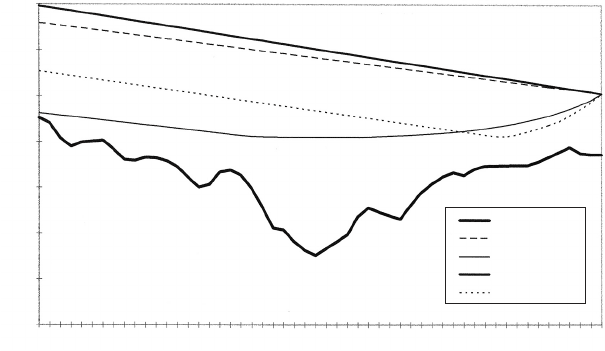
positive static with the suction tank at BWL, a modest recompression
under reversed flow occurs.
The extremes of piezometric level along the 5.4 km pipelines are
shown in Fig. 12.17. Maximum hydraulic gradients are those of
steady pumping flow since there is either no return flow upsurge or
only a modest upsurge. With TWL in the Rifa’a tanks, both flow rate
and also hydraulic levels are at a maximum. The minimum head over
most of the mains is largely dictated by the prevailing suction tank
level at Rifa’a. Only towards the Hamad Town end of the system
does the influence of the higher flow rate at TWL produce a more
significant fall in head.
It is often the case within low static head systems, after pumping fail-
ure, check valves remain open for prolonged periods, or reopen, possibly
on several occasions. In the absence of a significant positive static head
to produce a strong reversed velocity, large head rise at the vessel is
often avoided with peak head following flow reversal not reaching
steady pumping levels over most of a pipeline. The size of vessel may
be reduced if appreciable quantities of water continue to pass through
the pumping station after a power failure. Note that if trip occurs
with a low suction tank level, sufficient water must remain in the
tank to provide the necessary continued supply otherwise air may
start to be drawn into pump suction branches.
192
Chaina
g
e
(
m
)
i.l. (mBNSD)
max. (BWL)
min. (BWL)
max. (TWL)
min. (TWL)
Rifa'a/Hamad Town. Trip of two pumps
Elevation (mBNSD)
0
204
407
611
814
1018
1221
1425
1629
1832
2036
2239
2443
2646
2850
3053
3257
3461
3664
3868
4071
4275
4478
4682
4886
5089
5293
70
60
50
40
30
20
10
0
Fig. 12.17. Envelope curves in a low-lift system after pump trip
Pressure transients in water engineering

For the example illustrated, the pipeline profile may be described as
favourable from the point of view of avoiding sub-atmospheric pressure
conditions. In other instances such as where a higher summit occurred
part-way along the main, the vessel volume would require to be much
larger.
12.8 Vessels at a booster pumping station
Hydraulic transient conditions at a pumping station can also be influ-
enced by the presence of a suction main. Some aspects of possible
behaviour are illustrated in the following example which involves two
pumping stations. Figure 12.18 shows the longitudinal profile and the
steady flow hydraulic gradient of a pipeline system. A lengthy suction
main extends from Yarker Bank reservoir at chainage 0.0 km for more
than 20 km, where the first pumping station is sited at Bainbridge.
Downstream of Bainbridge pumping station delivery head is in excess
of 350 mAOD. At around 27 km is Stonehouse pumping station
where head is lifted once more, allowing water to reach Fossdale service
reservoir (SR). The suction main bifurcates at Bainbridge pumping
station supplying pumps serving the two mains and a set of duty
pumps on each branch delivers treated water into rising mains serving
Fossdale SR and Aysgarth SR. The Bainbridge to Aysgarth main has an
overall length of 9.1 km. Pump delivery head of around 300 mAOD is
193
Chaina
g
e
(
m
)
i.l. (mAOD)
Hydraulic gradient
Wensleydale Project. Yarker Bank to Fossdale
Elevation (mAOD)
0
977
1954
2932
3909
4886
5863
6840
7818
8795
9772
10 749
11 726
12 703
13 681
14 658
15 635
16 612
17 589
18 567
19 544
20 195
20 883
21 968
23 053
24 139
25 224
26 309
27 026
28 090
400
350
300
250
200
150
100
50
0
Fig. 12.18. Steady flow hydraulic gradient in a booster pump system
Pressure vessels
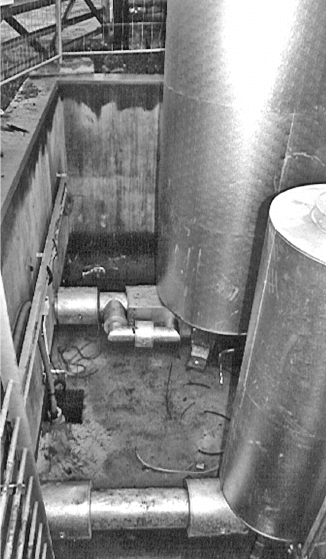
considerably lower than that of the pumps serving the main to Fossdale
SR. This difference in pump discharge head for the two mains has a sig-
nificant role to play in determining hydraulic transient behaviour.
Pressure vessels are located downstream of both the Fossdale and
Aysgarth pumps at Bainbridge and also upstream and downstream of
Stonehouse pumping station. Figure 12.19 shows these vessels which
are fitted with insulation jackets to avoid freezing in winter.
12.8.1 The upstream pumping station
Considering a station blackout at Bainbridge affecting both sets of
pumps, Fig. 12.20 illustrates the predicted variations in transient
head just upstream of the pumping station and downstream of both
pumps. After pumps are tripped at 10 s, Fig. 12.20 shows head in the
suction main rising steeply. Piezometric level downstream of the
Fossdale pumpset falls gradually under the influence of the pressure
vessel while head downstream of the Aysgarth pump also falls smoothly
194
Fig. 12.19. Insulated pressure vessels
Pressure transients in water engineering
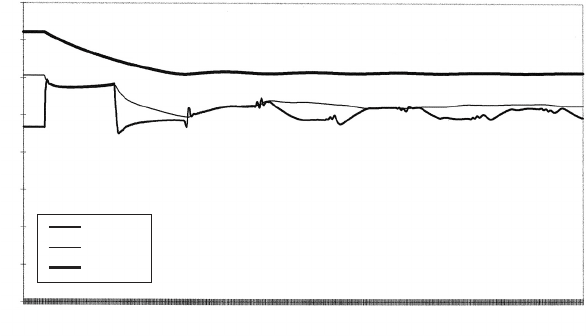
but at a greater rate due to the smaller vessel on this line. When head
on the suction side of the station exceeds head downstream of the
Aysgarth pump, that pump starts to turbine with flow passing through
the pump from upstream. Suction head and downstream head follow
one another closely. Head downstream of the Fossdale pump remains
unaffected by the suction level.
A compression wave travels upstream in the suction main to Yarker
Bank and is reflected back to Bainbridge arriving after about 45 s when a
steep fall in suction head occurs. The fall in head causes flow into the
Aysgarth line to cease and its pump check valve to close. Head down-
stream of the Aysgarth pump then falls smoothly as its vessel air volume
expands. Subsequent further wave reflections in the long suction main,
coupled with falling head downstream of the Aysgarth check valve,
allows this valve to reopen with a further period of flow through the
valve from upstream occurring. This sequence is repeated on one
further occasion.
Figure 12.21 shows the predicted variation of air volume within the
Aysgarth vessel. After trip at time ¼10 s, air volume starts to expand
but after a short interval volume is stabilised by the redevelopment of
flow through the pump. Wave reflection in the suction main causes
upstream head to fall and the check valve to close after about 45 s.
The Aysgarth main now becomes entirely reliant upon the vessel for
a continued supply of water. Air volume in the pressure vessel then
195
Time (s)
Suction
Aysgarth
Fossdale
Wensleydale Project. Heads at Bainbridge
Head (mAOD)
400
350
300
250
200
150
100
50
0
0.270
9.180
18.090
27.000
35.910
44.820
53.730
62.640
71.550
80.460
89.370
98.280
107.190
116.099
125.009
133.919
142.830
151.740
160.650
169.560
178.470
187.380
196.290
205.201
214.111
223.021
231.931
240.841
249.751
258.661
267.571
Fig. 12.20. Head variations after trip at booster station
Pressure vessels
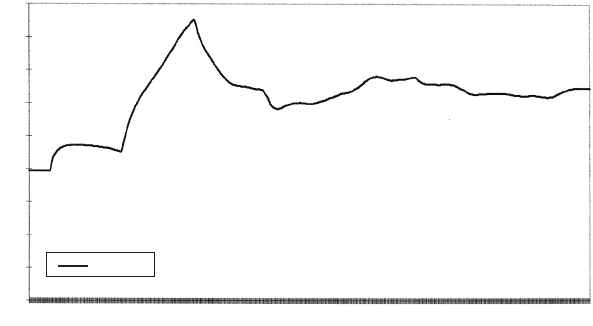
expands to its maximum. Subsequent reopening of the check valve at
around 80 s produces a reduction in vessel volume as head rises and
flow passes through the Aysgarth pump and check valve. Thereafter
only modest variations in vessel volume were predicted to occur.
The development of pump turbining action has been beneficial in
two respects.
(a) When head upstream of the pump exceeds the downstream head
and the pump commences to turbine, this acts as a form of ‘relief
valve’ allowing water to escape from the pressurised suction main
and preventing further significant head rise on the upstream side
of the pumping station.
(b) The continued flow through the pumps while turbining means that
the downstream pipeline is not entirely dependent upon the pres-
sure vessel for a supply of water to achieve hydraulic transient alle-
viation but some of the water is being provided by flow continuing
to pass through the pump during the intervals of turbining.The
capacity of pressure vessel can be made smaller than if no turbining
action occurred.
12.8.2 The downstream pumping station
Considering the second pumping station at Stonehouse, the suction
main at this station is also the discharge main of the upstream pumping
196
0.270
9.180
18.090
27.000
35.910
44.820
53.730
62.640
71.550
80.460
89.370
98.280
107.190
116.099
125.009
133.919
142.830
151.740
160.650
169.560
178.470
187.380
196.290
205.201
214.111
223.021
231.931
240.841
249.751
258.661
267.571
0.45
0.40
0.35
0.30
0.25
0.20
0.15
0.10
0.05
0
Volume
Volume (m
3
)
Time (s)
Wensleydale Project. Air volume/Aysgarth vessel
Fig. 12.21. Air volume variations after pump trip at booster station
Pressure transients in water engineering
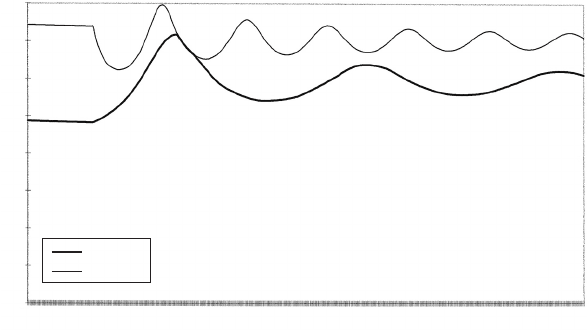
station. Events at one station will have an important influence upon
conditions at the neighbouring station. For instance, if a pump at one
of the stations is tripped this may require a pump at the second station
to be tripped after a time. Alternative conditions at the upstream Bain-
bridge station will be used to illustrate the changing effect on behaviour
at the downstream Stonehouse station. Relatively small pressure vessels
of identical gross volume but containing differing air charges and oper-
ating at different pressures were installed upstream and downstream of
the duty pump. These vessels were of the bladder type as described in
Chapter 13.
In the first of these illustrations the upstream pumps at Bainbridge
pumping station were tripped and the Stonehouse pump continued in
operation for a further 74 s before being tripped. During the intervening
period, suction head at Stonehouse gradually declined as illustrated in
Fig. 12.22. When the Stonehouse pump was switched off, suction head
started to rise smoothly, influenced by the upstream pressure vessel. On
the delivery side of the station, head started to fall smoothly controlled
by the downstream pressure vessel. The increasing suction head reaches
the downstream head which is falling at time ¼95 s. At this time the
check valve reopens and flow occurs from the suction side to the dis-
charge side of the pump. The upstream and downstream heads are
quite similar until around 100 s when the falling upstream head
causes the check valve to shut and flow through the pump to cease.
197
u/s head
d/s head
Head (mAOD)
Time (s)
Wensleydale Project. Head at Stonehouse
400
350
300
250
200
150
100
50
0
59.890
64.395
68.900
73.405
77.910
82.415
86.920
91.425
95.930
100.440
104.940
109.450
113.950
118.460
122.960
127.470
131.970
136.480
140.980
145.490
149.990
154.500
159.000
163.510
168.010
172.520
177.020
181.530
186.030
190.540
Fig. 12.22. Head variations at booster station after all pumps are tripped
Pressure vessels
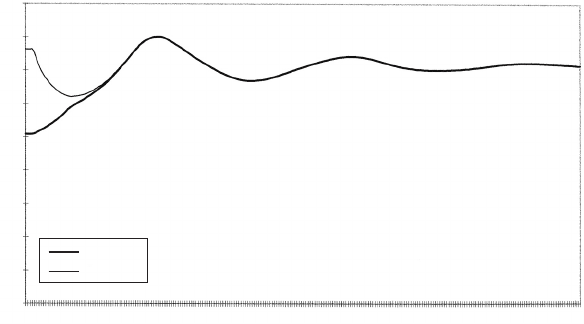
Thereafter heads upstream and downstream vary independently with
the check valve remaining closed. The different periods of oscillation
upstream and downstream of Stonehouse pumping station are indica-
tive of the relative lengths of suction and delivery mains.
As far as velocity variations are concerned, after pump trip at 75 s,
velocity through the pump and check valve decelerates rapidly until
check valve closure. The check valve is assumed to have a good closure
performance. In the suction main upstream of the vessel, velocity
decelerates gradually, controlled by the upstream pressure vessel. In
the delivery main below the downstream vessel, velocity also decreases
relatively gradually under the influence of this vessel until 81 s when
flow reverses and some refilling of the vessel occurs. When upstream
head exceeds downstream head after about 95 s the check valve
reopens and there is a modest flow through the pumps until around
100 s when the check valve shuts once more.
In the second scenario the Stonehouse pump is tripped after 1 s while
the upstream Bainbridge pump continues to operate so that suction
head at Stonehouse is at a maximum during the event. Figure 12.23
shows the resultant variations in head upstream and downstream of
the Stonehouse pumping station. Head on the suction side of the
pump rises smoothly influenced by the upstream vessel while the
198
u/s head
d/s head
Head (mAOD)
Time (s)
Wensleydale Project. Head at Stonehouse
450
400
350
300
250
200
150
100
50
0
0.265
2.385
4.505
6.625
8.745
10.865
12.985
15.105
17.225
19.345
21.465
23.585
25.705
27.825
29.945
32.065
34.185
36.305
38.425
40.545
42.665
44.785
46.905
49.025
51.145
53.265
55.385
57.505
59.625
61.745
63.865
65.985
Fig. 12.23. Head variations at downstream station while upstream pumps are
running
Pressure transients in water engineering

delivery head declines gradually controlled by the downstream vessel.
As upstream and downstream heads approach one another after
about 6 s, the check valve reopens and flow is re-established through
the pump. The suction and delivery heads are closely linked thereafter
with a damped oscillation occurring.
As far as velocities are concerned, following pump trip velocity
through the pump decelerates rapidly with check valve closure follow-
ing. Velocities in the suction and delivery mains again decelerate more
gradually, controlled by their respective pressure vessels. Flow reverses
in the delivery main after about 7
1
2
s and becomes positive once more at
around 14 s. The suction main velocity remains positive throughout. At
about 6 s the check valve reopens and flow passes through the pump.
The check valve remains open thereafter. As time passes, the velocities
gradually approach a new smaller steady flow condition under the
action of the Bainbridge pump alone.
This case demonstrates that a wide range of behaviours can occur at a
booster station, ranging from little or no turbining action at a failed
pump to the development of a new steady flow through the pump
which has been switched off. The suction and delivery main vessels
are instrumental in controlling rates of change of velocity and head in
the mains but at the price of producing a rapid deceleration of flow
through the failing pump. This high rate of deceleration carries with it
the risk of check valve slam if a suitable closure performance is not
achieved by the selected valve. The response of check valves is discussed
in detail in Chapter 20.
12.9 Summary of response with a pressure vessel included
A booster pumping station will have appreciable lengths of pipeline
both upstream and downstream of the pumps. There may be as great
a need for pressure transient protection of the suction main as there
is for a rising main.
Where a pressure vessel is placed on the delivery side of a pumping
station it can be shown that the rate of flow deceleration through the
pumps and their associated check valves is increased. If a suction
main is present then the increased rate of deceleration will impact
adversely on pressure transients in this main, tending to make surging
more severe. If a pressure vessel is then installed on the suction side
of the pumps in order to suppress these transient effects it will act to
receive water following a pumping failure. The pressure in the upstream
vessel will rise while that in the downstream vessel falls. The ability of
199
Pressure vessels
water to flow into the suction vessel rather than continue to the pumps
has the effect of further aggravating rates of flow deceleration through a
failing pump thus imposing more severe closure conditions on the pump
discharge check valves.
As the transient progresses it is not uncommon for the head upstream
of the pumps to exceed the downstream head. Then the check valves
will reopen, allowing flow to re-establish and also largely stabilising air
volumes within the vessels. Following flow reversal upstream and down-
stream of the pumping station, the upstream head will start to fall while
downstream head rises. Check valves will then reclose.
In the case of high-lift pumps, the check valves may not reopen if the
head upstream of the pumps does not rise to the minimum level of fall-
ing head in the downstream vessel. In these circumstances the more
rapid closure of the check valves will mean that more water will
enter the upstream vessel and more water will be withdrawn from the
downstream vessel. There will be a tendency for the necessary vessel
volumes to increase above the volumes required where a vessel was
installed only on one side of a pumping station.
As with a pressure vessel located on the downstream side of a pump-
ing station, throttling of flow can also be applied to the upstream vessel.
This throttling action may be applied either during inflow to the vessel
or to the outflow depending upon a need to suppress the upsurge on the
suction side (throtting of inflow) or the downsurge (throtting of out-
flow).
A pressure vessel may also be used as part of an overall protection
package. It can be used to prolong the time taken for piezometric
level to fall, at the start of a main, to a sufficient extent that no
unacceptably low pressures are developed between downstream points
on the main where other forms of protection are present.
Appendix Equations for estimating air vessel parameters
When a detailed hydraulic transient analysis of a pipeline system has
been commissioned and the time and costs associated with constructing
an accurate model have been covered then it is not so important to
have an initial estimate of pressure vessel characteristics. In other
instances, for instance where a tender is being prepared and a sum is
to be included for pressure transient protection, it is useful to be able
to price the pressure vessel installation as accurately as possible.
Should the contract not be awarded, any expense may not be recover-
able and so analysis time should be as brief as possible. The use of design
200
Pressure transients in water engineering
charts can be very helpful in this respect. In other circumstances, for
example during a meeting to discuss a range of aspects of a project,
questions may be raised unexpectedly about transient protection and
its likely costs. If charts for vessel selection are not to hand then it
may be appropriate to resort to an analytical approach as described
below.
There are essentially three initial questions that may need to be
answered for a proposed pressure vessel installation:
(a) What is the necessary capacity of pressure vessel and corresponding
gas volumes?
(b) What will be the peak pressure during the upsurge after flow
reversal?
(c) If the peak pressure from (b) is excessive, what degree of throttling
at the vessel inlet is necessary to reduce the peak pressure to an
acceptable extent?
The primary function of the vessel installation is to reduce rates of
deceleration and acceleration of the water column in the pipeline.
Assuming a relatively ‘slow’ transient event, then as a first approxima-
tion incompressible flow theory can be used allowing simpler physics
than the ‘elastic’ analysis. In common with the use of design charts to
estimate vessel characteristics, the water is assumed incompressible
and the conduit walls rigid.
The following information is necessary to conduct an assessment:
(a) pipeline profile or ground-level elevation along the route
(b) length and diameter of main
(c) design flow rate(s)
(d) maximum and minimum allowable pressures
(e) resistance to flow.
Vessel volume will often be determined by the need to control mini-
mum pressures during the initial downsurge, with peak pressures during
the return upsurge possibly requiring incorporation of a throttle device
to control inflow to the vessel.
A12.1 Equation of motion
Consider the pipeline system fitted with a pressure vessel as shown in
Fig. A12.1. It is assumed that when pumps are tripped they cease to
deliver flow instantaneously. A gas law of the form p
abs
Vol
n
¼
constant, is applicable, where:
201
Pressure vessels
